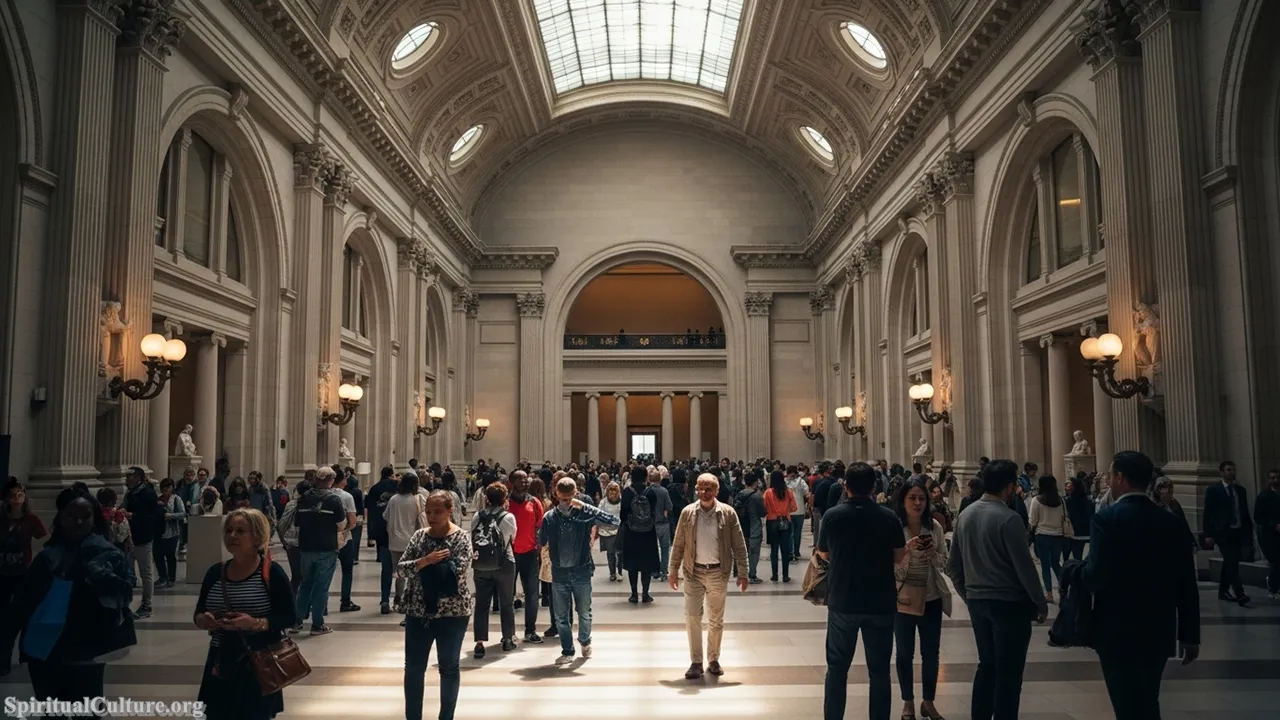The State of Qatar, a land known globally for its rapid modernization and visionary architecture, holds a historical narrative that stretches back thousands of years, a story often preserved in its forts, mosques, and archaeological ruins. At Spiritual Culture, we believe true cultural importance lies not just in antiquity, but in the spiritual and social impact a site holds for the identity of a nation and its people. The historical sites of Qatar are a testament to the ingenuity and enduring faith of its coastal and desert communities, reflecting the traditional Arab way of life before the oil boom.
While the modern landscape dazzles, these heritage sites provide the essential context—the soul—of the Qatari identity. They stand as enduring symbols of the nation’s deep-rooted past, anchored in Islamic principles and the harsh, yet rewarding, realities of the Arabian Gulf. Our ranking prioritizes sites that offer tangible evidence of past spiritual life, community organization, and cultural continuity up to the Current Time of Writing, serving as vital links to the ancestral memory.
These locations represent more than just ancient stones; they are living repositories of Qatari heritage. From the UNESCO-listed remains of a thriving pearling port to the grand mosque that serves as the nation’s spiritual heart today, each site offers a reflective glimpse into the cultural DNA that informs the modern Qatari state. They underscore the deeper meaning of resilience and the powerful role of faith in community formation, making them truly the most important historical sites for Spiritual Culture’s discerning audience.
Table of the Top 10 Historical Sites in Qatar with the Greatest Cultural and Spiritual Influence
| Rank | Site Name | Primary Era/Date | Cultural Significance | Spiritual Influence/Status |
|---|---|---|---|---|
| 1 | Al Zubarah Archaeological Site | 18th – 19th Century | UNESCO World Heritage Site; Key Global Pearling/Trade Port | Testimony to Islamic trading culture; abandoned urbanity reflects ephemerality. |
| 2 | Imam Muhammad ibn Abd al-Wahhab Mosque (State Grand Mosque) | 2011 (Modern Structure) | Qatar’s largest mosque; National Symbol of Faith | Central hub for national spiritual and religious life. |
| 3 | Souq Waqif | Pre-20th Century (Revitalized) | Living cultural marketplace; Social and Economic heart of Old Doha | Maintained traditional architecture provides a spiritual link to community past. |
| 4 | National Museum of Qatar (NMoQ) / Historic Palace | Historic Palace (Early 20th C.) / Museum (2019) | Architectural masterpiece; Chronology of Qatari National Identity | Integrates the historic palace of the former ruler, rooting modernity in heritage. |
| 5 | Al Jassasiya Rock Art Site | Neolithic to 18th Century | Oldest archaeological evidence of human activity (Petroglyphs) | Provides an ancient, pre-Islamic spiritual connection to the land and cosmology. |
| 6 | Al Koot Fort (Doha Fort) | Late 19th Century (1880s) | Former police station/prison; Symbol of Defense and Governance | Preserves the physical memory of early modern state control and security. |
| 7 | Barzan Towers | Late 19th Century | Watchtowers for water sources; Key part of defense system | Represents the deep spiritual value placed on life-giving water and communal protection. |
| 8 | Katara Cultural Village | 2010 (Modern Project) | Hub for arts, opera, and traditional crafts (including a grand mosque) | A contemporary, living space dedicated to preserving and celebrating intangible culture and arts. |
| 9 | Al Ruwaida Archaeological Site | Early Islamic – Late Islamic | One of the largest archaeological settlements in Northern Qatar | Remains of a major maritime and settlement center before Al Zubarah’s rise. |
| 10 | Murwab Archaeological Site | 8th – 9th Century (Abbasid Era) | Site of an early Islamic fort, possibly Qatar’s oldest | Direct link to the very beginnings of formalized Islamic presence and governance in Qatar. |
Top 10. Murwab Archaeological Site
Murwab represents a fundamental piece of Qatar’s historical puzzle, offering a tangible link to the early Islamic or Abbasid era of the 8th and 9th centuries. Located on the west coast, the site contains the remains of a defensive fort and a large settlement, demonstrating that life and organized governance existed long before the pearl trade reached its zenith. For Spiritual Culture, Murwab establishes the antiquity of Qatar’s engagement with the wider Islamic civilization, showcasing foundational architectural styles and evidence of a self-sustaining early settlement.
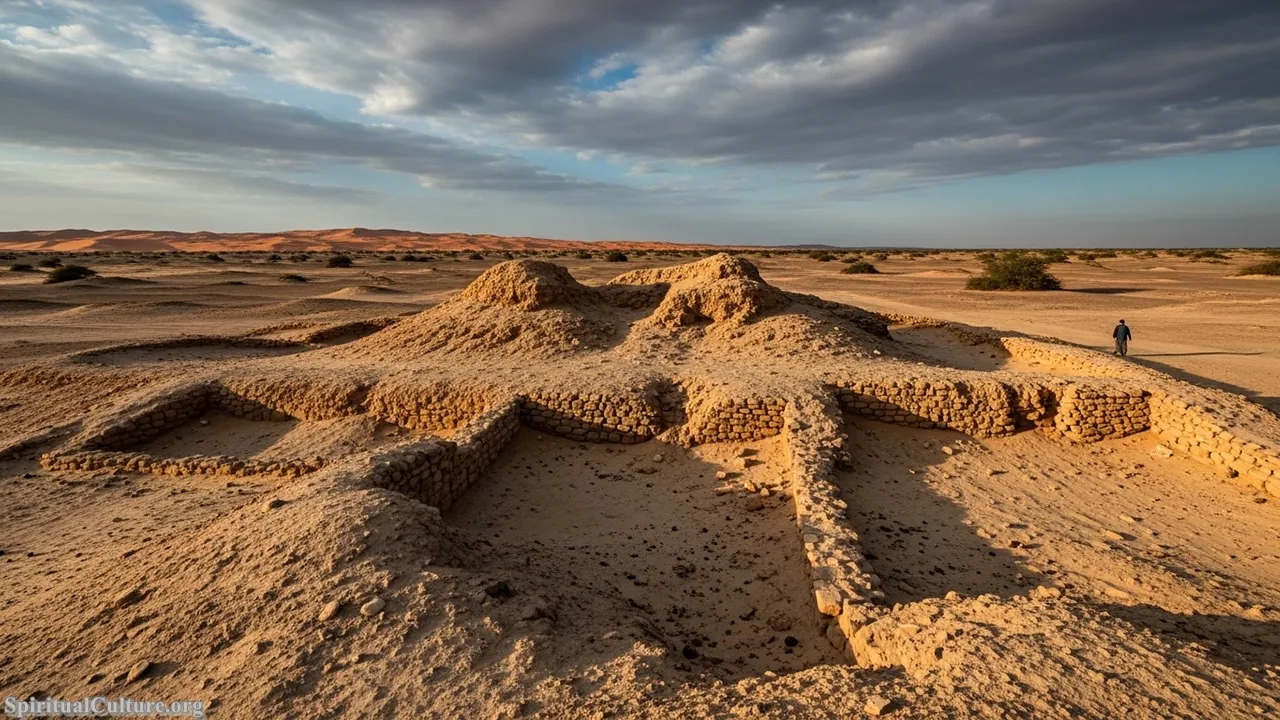
The fort’s existence at Murwab, possibly the oldest Islamic fort discovered in the country, gives it a profound spiritual impact, symbolizing the early establishment of faith and protection in a challenging environment. Its ruins tell a story of dedication to Islamic settlement, a place where people lived, prayed, and protected their community under a new spiritual banner. The strategic presence of a fort in such a remote area underlines the critical role of faith and governance in establishing early socio-political structures in the Gulf.
The moral lesson offered by Murwab is one of historical continuity and the deep roots of Islamic life in Qatar. The preserved foundations urge us to look beyond modern development and appreciate the struggles of the earliest communities to anchor a way of life based on their beliefs. Its preservation value lies in its power to teach contemporary Qataris and the world that their cultural story is not merely centuries, but well over a millennium old, starting with the establishment of Dar al-Islam.
Cultural/Spiritual Highlights:
- May be the oldest Islamic fort in Qatar, dating to the Abbasid Caliphate.
- The layout reveals an early Islamic settlement pattern, showcasing communal living.
- Confirms Qatar’s integration into the vast Islamic world over 1,200 years ago.
Top 9. Al Ruwaida Archaeological Site
Al Ruwaida, positioned in the northern region of Qatar, is one of the largest archaeological complexes pre-dating the famed Al Zubarah, functioning as a major settlement during the Late Islamic period. As of the Current Time of Writing, extensive excavations have revealed a thriving coastal town with evidence of trade links, a large mosque, and substantial courtyard houses. Its scale and complexity demonstrate the rich pre-modern urban tradition of the peninsula, serving as a critical cultural reference point before the 18th-century shifts.
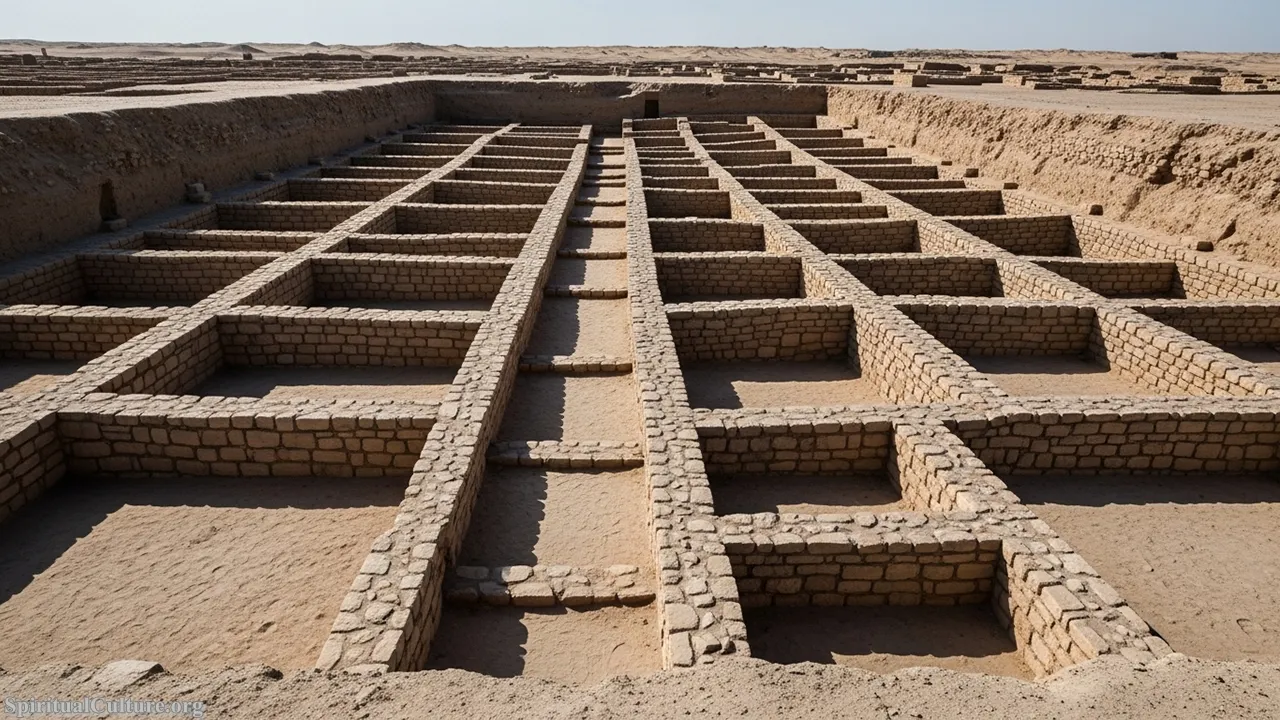
The reason for Al Ruwaida’s importance for Spiritual Culture is the clarity it offers regarding the spiritual and social organization of its community. The remnants of a large, centrally-located mosque and an organized urban layout suggest a community where faith was a core organizing principle of daily life and trade. It proves the enduring Qatari capacity to sustain a complex, faith-driven maritime culture, preparing the cultural groundwork for the later, more famous pearling centers.
Reflecting on Al Ruwaida, the preservation value is paramount as it safeguards the cultural memory of the precursor settlements that defined Qatar’s coastal economy. The ruins inspire reflection on the cyclical nature of human settlements and the resilience required to thrive in the harsh Gulf climate. It serves as a spiritual reminder that while individual towns may rise and fall, the core traditions and commitment to faith endured across centuries.
Cultural/Spiritual Highlights:
- A major settlement and trading center that peaked before the rise of Al Zubarah.
- Archaeological evidence includes a large mosque structure at the heart of the village.
- Demonstrates the early urban tradition of Qatar’s coastal communities.
Top 8. Katara Cultural Village
Katara Cultural Village, though a modern creation (inaugurated in 2010), earns its place due to its unparalleled commitment to preserving Qatar’s Intangible Cultural Heritage, a concept increasingly important to Spiritual Culture. It is a purpose-built space designed to celebrate traditional Qatari architecture, arts, theatre, and intellectual discourse, making it a living museum for the nation’s contemporary cultural identity. Its architecture and public spaces consciously reflect the spiritual values of community, creativity, and Arab hospitality.
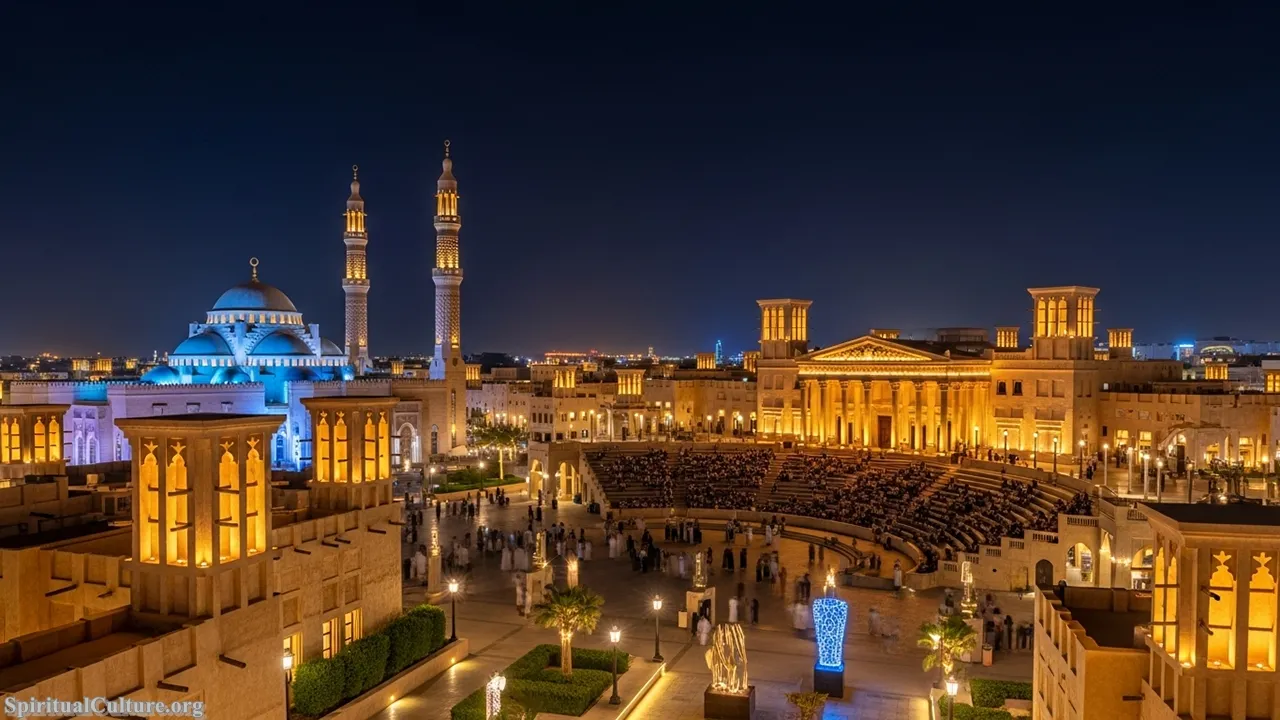
The spiritual impact of Katara is found in its function as a vibrant masjid (gathering place) for culture, featuring stunning mosques, a grand amphitheater for community events, and galleries that showcase Islamic arts and calligraphy. It provides a contemporary, accessible platform for cultural education and interfaith dialogue, effectively acting as Qatar’s modern town square and intellectual majlis. By intentionally creating a space that looks backward in its design while looking forward in its programming, Katara roots modernity in the collective cultural soul.
The moral lesson of Katara is that preservation is an active, living process, not merely the maintenance of ruins. It reflects a state-level commitment to safeguarding cultural pride in the face of rapid globalization. The sheer scale and intentionality of the project underscore the humanistic value of ensuring future generations have a tangible, beautiful space to experience and celebrate the core spiritual and cultural tenets of Qatari society.
Cultural/Spiritual Highlights:
- A major modern center dedicated to preserving Arab and Qatari intangible heritage.
- Home to the stunning Katara Mosque and the unique Gold Mosque.
- Functions as a national and international hub for cultural exchange and dialogue.
Top 7. Barzan Towers
Standing tall in Umm Salal Mohammed, the Barzan Towers were originally constructed in the late 19th century and served a vital function beyond mere defense: they were watchtowers used to monitor the movement of pearls and, critically, to observe the rising of the new moon—a profound spiritual duty. For Spiritual Culture, these towers symbolize the enduring spiritual value of security and sustenance for the traditional Qatari community.
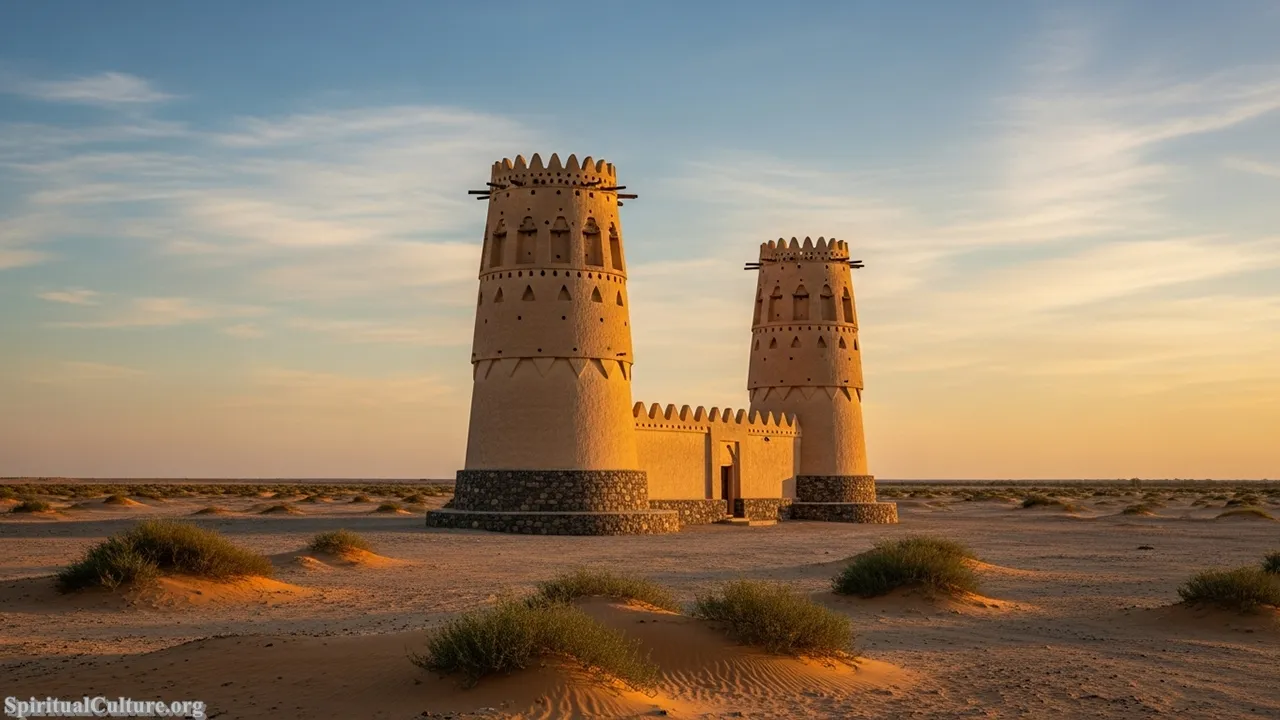
The reason for their high cultural importance is their role in protecting the vital fresh groundwater in the Wadi Umm Salal area. In the arid desert, water is synonymous with life, making the preservation of its source a fundamental spiritual and communal responsibility. Furthermore, their height was utilized for ru’yat al-hilal, the sighting of the new crescent moon to determine the start and end of the holy month of Ramadan, linking their physical structure directly to the core rituals of the Islamic faith.
The preservation value of the Barzan Towers lies in their representation of traditional Qatari architectural ingenuity and their dual role as defensive and astronomical observation posts. They encourage reflection on the resourcefulness of the ancestors and the central role of faith in their strategic planning. They are silent sentinels reminding us of the fragility of life in the desert and the necessity of communal vigilance and spiritual dedication.
Cultural/Spiritual Highlights:
- “Barzan” means “high place,” highlighting the towers’ strategic lookout function.
- Historically used for ru’yat al-hilal (sighting the crescent moon) to mark Ramadan.
- Protected precious local groundwater sources, linking them to the spiritual value of water (Zamzam).
Top 6. Al Koot Fort (Doha Fort)
Al Koot Fort, located prominently near the traditional center of Doha, was built in 1880, initially by the Ottoman forces and later repurposed by Sheikh Abdullah bin Jassim Al Thani. While often viewed simply as a military structure, its cultural significance for Spiritual Culture is rooted in its evolution as a symbol of early national security and evolving governance in the modern era. Its mud-brick and stone architecture ground it firmly in the heritage of defensive Arabian structures.

Al Koot Fort’s ranking reflects its spiritual impact as a physical testament to the early steps of Qatar’s move toward sovereign stability amidst regional power shifts. The fort, having served variously as a police station and a prison, holds the collective memory of the city’s growth and the firm hand of early modern state authority. It is a historical marker in the transition from decentralized tribal authority to a unified national structure, a necessary political step to protect the spiritual and cultural way of life.
The moral lesson from Al Koot is the understanding that true cultural preservation requires peace and stability. The fort’s resilient walls reflect the national resolve to defend its identity and spiritual independence. By preserving it in the heart of the capital, Qatar ensures the physical memory of the challenges faced during the critical late 19th and early 20th centuries is never lost, offering a tangible backdrop for stories of national consolidation.
Cultural/Spiritual Highlights:
- A key architectural symbol of defense and early state governance in Doha.
- Location near Souq Waqif places it at the center of early modern civic life.
- Its thick, traditional walls reflect the timeless Arabian construction techniques.
Top 5. Al Jassasiya Rock Art Site
Al Jassasiya, situated on the northeast coast, is the most extensive and impressive of Qatar’s rock carving (petroglyph) sites, featuring nearly 900 carvings on limestone outcrops. These unique patterns, including fish, footsteps, cup marks, and designs resembling ancient board games, date from the Neolithic period through to the 18th century. For Spiritual Culture, this site is unparalleled in offering a primeval, non-scriptural connection to the land and the ancient consciousness of its inhabitants.
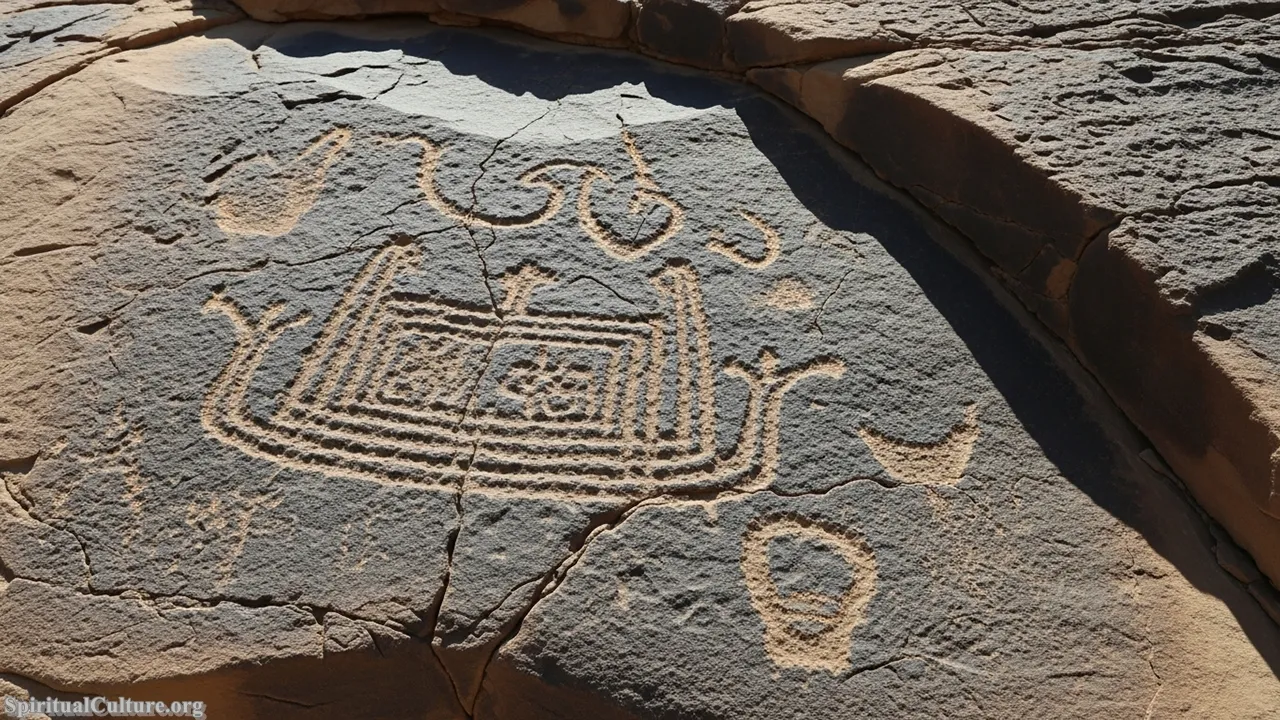
The spiritual impact of Al Jassasiya is profound: it is the earliest known artistic expression and cultural inscription on the Qatari peninsula. The meaning of the carvings is debated, but they certainly reflect ancient concerns with nature, subsistence (fishing/hunting), and possibly early ritual or social organization (the “board game” hypothesis). It provides a deep, multi-millennial sense of belonging and continuity, proving that the Qatari land has been a home for human spiritual and imaginative life since prehistory.
The preservation value of this site is immense; it is an irreplaceable window into the deep past, connecting modern Qataris not just to their Islamic heritage, but to the very first human communities to inhabit their shores. Reflecting on the Al Jassasiya carvings inspires a sense of humility and awe at the long timeline of human existence and the universal impulse to leave a lasting spiritual mark upon the earth.
Cultural/Spiritual Highlights:
- Features the largest concentration of petroglyphs in Qatar, dating back millennia.
- Carvings include rare “board game” designs, indicating complex social activity.
- Provides a direct, tangible link to the pre-Islamic, ancient human presence and artistic expression on the peninsula.
Top 4. National Museum of Qatar (NMoQ) / Historic Palace
The National Museum of Qatar, opened in 2019, is a spectacular architectural feat inspired by the desert rose crystal, yet its cultural importance for Spiritual Culture lies in its integration of the historic palace of Sheikh Abdullah bin Jassim Al Thani (1880–1957). The museum’s narrative expertly traces the nation’s history from prehistory to the present, focusing on identity, natural history, and the discovery of oil.
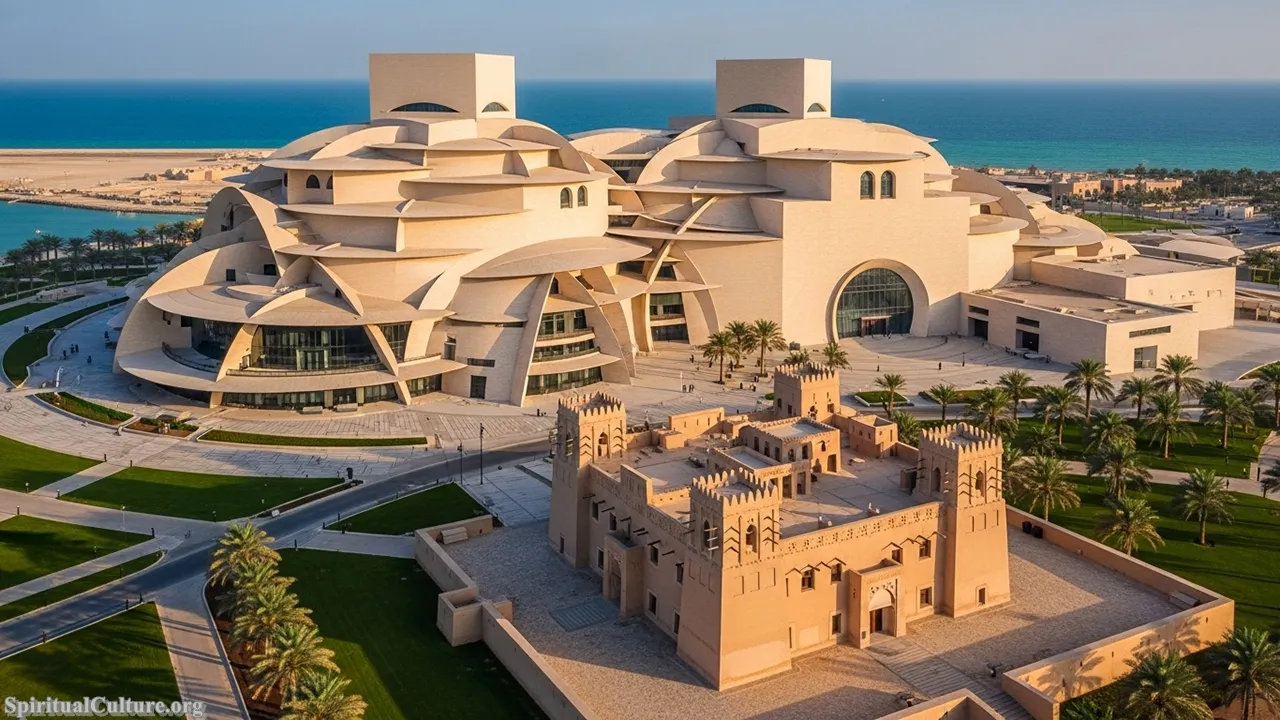
The spiritual impact is dual-layered. The modern, soaring architecture symbolizes the aspirational spirit of contemporary Qatar, while the meticulously preserved Historic Palace at its core represents the foundational spiritual and cultural anchor of the nation-state. This palace was the seat of government for 25 years and the family home of the former Emir. Its preservation ensures that the story of Qatar’s political and spiritual coming-of-age remains physically centered within its grandest cultural institution. It is where the nation’s past literally informs its future.
The NMoQ offers a potent moral lesson: true progress must be rooted in an honest, comprehensive understanding of one’s heritage. The structure reflects the Qatari conviction that the nation’s spiritual identity, built on Islamic values and Arabian traditions, is the true engine of its unprecedented development. Its preservation value lies in its immersive storytelling, ensuring that the collective memory of the journey from Bedouin life to global power is passed down with clarity and pride.
Cultural/Spiritual Highlights:
- Architecture is inspired by the desert rose, symbolizing the nation’s connection to its natural environment.
- Encompasses the meticulously restored Historic Palace of Sheikh Abdullah bin Jassim Al Thani.
- Serves as the nation’s principal repository of cultural memory and national identity.
Top 3. Souq Waqif
Souq Waqif, or the “Standing Market,” is the spiritual and commercial heart of Doha. Though largely reconstructed in the early 21st century using traditional Qatari architecture, its location and function remain historically continuous, occupying the site of an ancient trading hub near the riverbed (or wadi) where Bedouins and coastal traders once met. For Spiritual Culture, it is Qatar’s most important living heritage site.

Its ranking is justified by its powerful, enduring spiritual impact as the communal majlis of the city. The Souq fosters the intangible heritage of social interaction, negotiation, hospitality, and traditional commerce that has defined the Arabian Peninsula for centuries. The maze of alleyways, the scent of spices and oud, and the presence of traditional falconry and craft shops keep the soul of the old city palpable and alive, serving as a visceral, multi-sensory link to the ancestral past.
The moral lesson of Souq Waqif is the celebration of authenticity through revitalization. Its success demonstrates that tradition, when sensitively integrated, can thrive in the modern era, becoming an economic and cultural pillar. Its preservation ensures the survival of communal and social values—the very fabric of traditional Qatari society—making it a vital spiritual gathering place for the community and a place for respectful cultural exchange for visitors as of the Current Time of Writing.
Cultural/Spiritual Highlights:
- The most important living heritage site in Doha, preserving traditional social customs.
- Its architecture and layout reflect the traditional Qatari and Gulf town planning.
- The central location serves as the enduring social and commercial majlis (gathering place) of the capital.
Top 2. Imam Muhammad ibn Abd al-Wahhab Mosque (State Grand Mosque)
In terms of sheer spiritual significance in the Current Time of Writing, the Imam Muhammad ibn Abd al-Wahhab Mosque, or the Qatar State Grand Mosque, is arguably the most important building in the entire nation. Completed in 2011, this massive structure is the official national mosque, accommodating over 30,000 worshippers. Its design gracefully blends traditional Arabic and modern architectural elements, reflecting a deep respect for heritage while embracing a modern scale.

The spiritual impact is immediate and profound: this mosque is the nation’s central place of worship, hosting major religious events, prayers, and cultural sermons. It symbolizes the central, unifying role of Islam (specifically the Wahhabi tradition) in the Qatari state and its identity. Its grandeur and prominent placement underscore the nation’s constitutional commitment to Islamic law and its spiritual foundation, serving as a beacon of faith for the entire populace. Its existence is a powerful statement of religious conviction and national spiritual unity.
The preservation value lies in its role as a living monument of faith that actively shapes the nation’s present and future. It provides a moral and spiritual compass for the Qatari society. The structure, while new, embodies the timeless function of the mosque in Islamic civilization—as a place not only of worship but of learning, community, and social gathering—making it an essential element of Qatar’s cultural continuity.
Cultural/Spiritual Highlights:
- The official national mosque of Qatar, symbolizing the centrality of Islam to national identity.
- A major hub for national religious gatherings, services, and cultural events.
- Architecture beautifully blends traditional Qatari Islamic design with a modern, monumental scale.
Top 1. Al Zubarah Archaeological Site
The Al Zubarah Archaeological Site, a UNESCO World Heritage Site since 2013, stands as the indisputable most important historical site in Qatar. Founded in the mid-18th century, it was once a globally significant pearling and trading town, connecting the Gulf, the Indian Ocean, and Western Asia. The site’s cultural importance is that it is the best-preserved, most extensive example of an 18th-to-19th-century Gulf merchant town surviving in the region today.

For Spiritual Culture, Al Zubarah is not just ruins; it is an outstanding testimony to the spiritual and economic foundations of Gulf culture. The town’s rapid rise and subsequent abandonment offer a deeply spiritual contemplation on the ephemerality of worldly wealth (pearl trade) and the resilience of a maritime culture built on Islamic trading principles. The preserved remains of its mosques, courtyard houses, and defensive walls offer a unique, fixed snapshot of organized, faith-based urbanity before the age of oil, justifying its top rank.
The preservation of Al Zubarah, protected by a layer of desert sand that covered it after its destruction in 1811, is a near-miraculous testament to history. It provides an irreplaceable moral lesson: the complex legacy of the pearling economy was the true forge of the modern Gulf’s identity, demonstrating sophisticated urban planning, defense, and deep spiritual life. Its UNESCO status ensures its legacy is protected as a global heritage, affirming the profound cultural contribution of the Qatari people to world history.
Cultural/Spiritual Highlights:
- Qatar’s only UNESCO World Heritage Site, recognizing its global importance.
- The most extensive and best-preserved example of an 18th-19th century Gulf merchant town.
- Its history reflects the spiritual and economic reliance on the pearling industry—the soul of the old economy.
Conclusion
The historical sites of Qatar collectively narrate a powerful and often overlooked story of resilience, faith, and cultural tenacity. From the millennia-old silent inscriptions at Al Jassasiya to the monumental spiritual declaration of the State Grand Mosque, these locations provide the essential context for understanding the rapid transformation of the nation. At Spiritual Culture, we celebrate these sites as tangible anchors to the past, each one demonstrating that the humanistic spirit, guided by faith and community, is the most enduring heritage of all.
As Qatar continues its trajectory into the future, the preservation of these historical and spiritual sites ensures that the nation remains deeply connected to the wisdom, struggles, and values of its ancestors. They teach us that true wealth is found not only beneath the earth, but in the collective memory and spiritual depth of a people. By honoring these sites, Qatar secures its soul, ensuring that its identity is forever rooted in the profound history of the Arabian Gulf.




